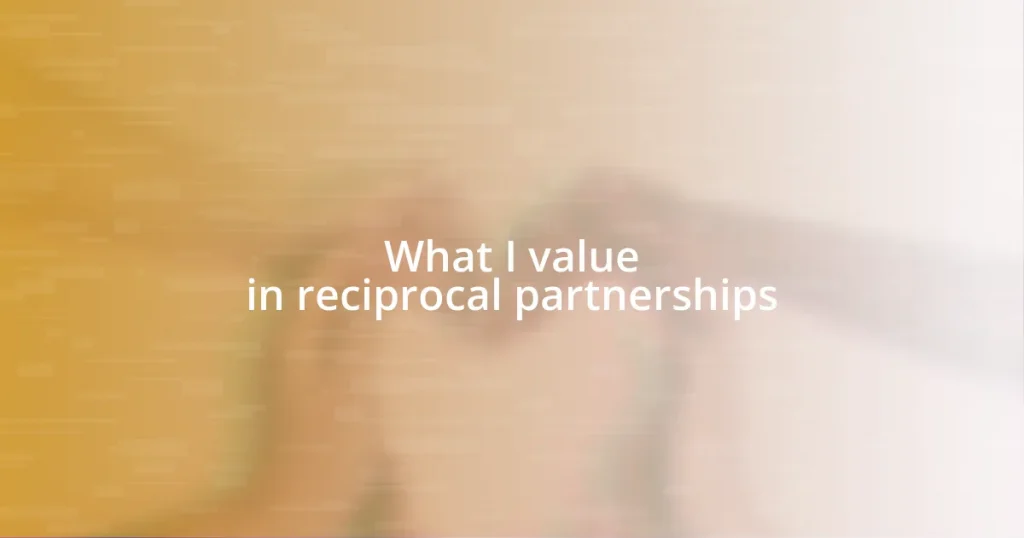Key takeaways:
- Reciprocal partnerships thrive on mutual benefit, trust, and effective communication, promoting shared success and motivation.
- Key elements of strong partnerships include complementary skills, ongoing commitment to relationship-building, and flexibility in adapting to challenges.
- Building trust requires consistency, transparency, and active listening, which fosters deeper connections and enhances collaboration.
- Regular check-ins and a culture of appreciation are vital for maintaining partnerships, helping to address concerns and celebrate achievements.
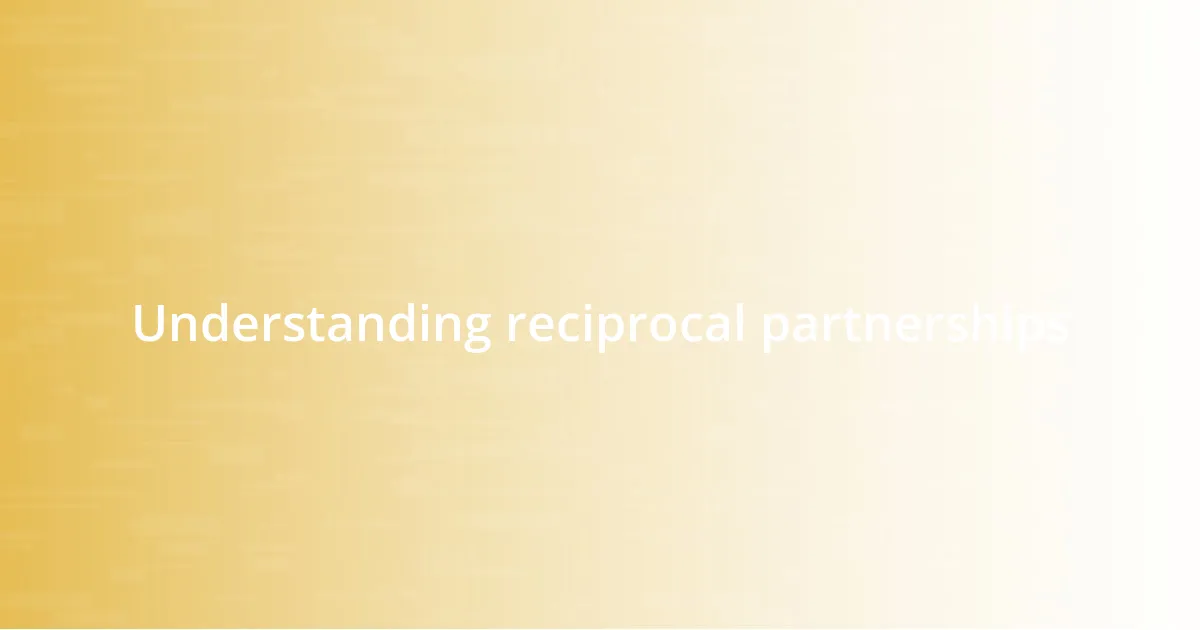
Understanding reciprocal partnerships
Reciprocal partnerships are built on the foundation of mutual benefit and trust. I recall a time when I collaborated with a friend on a community project. We each brought different strengths to the table—my friend had an amazing knack for organization while I loved connecting with people. This balance not only elevated our project but deepened our friendship.
At the heart of reciprocal partnerships lies genuine communication. Have you ever thought about how open dialogue fosters understanding? I remember a heated discussion with a colleague that initially felt uncomfortable, but it turned into a breakthrough. By sharing our perspectives honestly, we recalibrated our approach, ensuring that both of our needs were met.
Additionally, the emotional investment in reciprocal partnerships cannot be overstated. It’s not just about the give-and-take—it’s about feeling valued and respected. I often reflect on my experiences where I felt truly appreciated, like when a teammate acknowledged my contribution in front of the group. Those moments ignite a sense of commitment that energizes the partnership and propels us toward common goals.
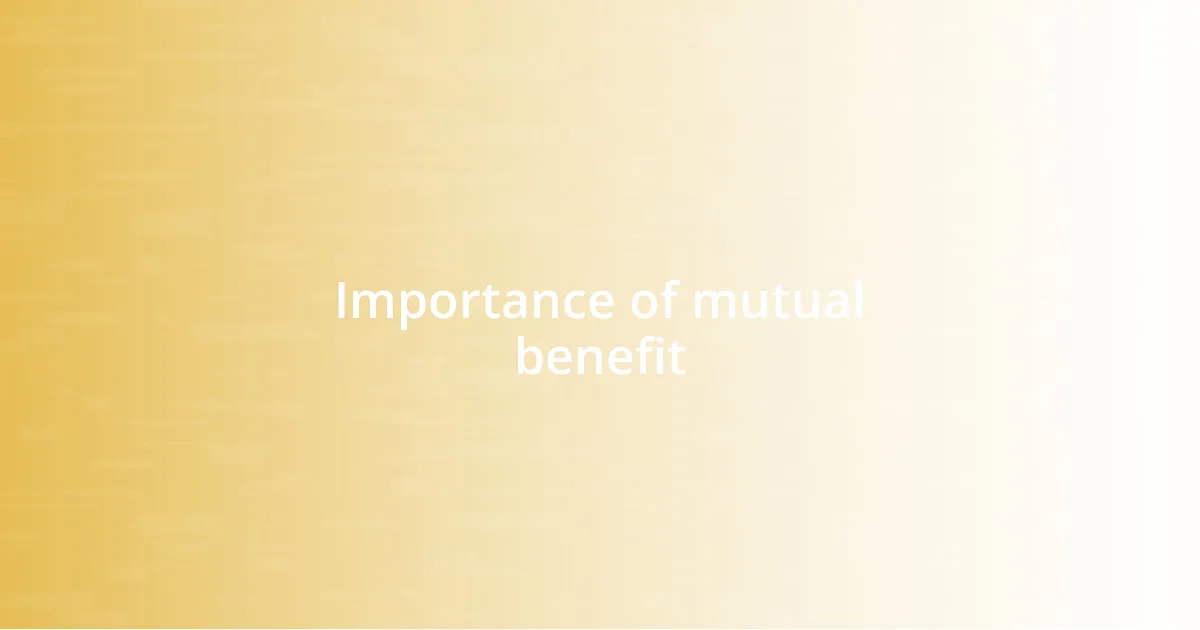
Importance of mutual benefit
Mutual benefit is essential in any partnership; it creates a win-win environment where both parties feel valued. I recall negotiating a small business deal where my partner and I carefully outlined our expectations. By ensuring that each of us would gain something significant—whether it was financial or experiential—we established a solid foundation of trust. This not only made the arrangement feel fair but also motivated us to collaborate more effectively.
Here are some key reasons why mutual benefit is crucial:
- Enhanced trust: Knowing that both sides are gaining creates a stronger bond.
- Increased motivation: When I feel like I’m getting something meaningful in return, I’m more driven to contribute fully.
- Long-term sustainability: I’ve seen partnerships flourish over time when both parties reap the rewards of their efforts.
- Improved communication: Open discussions about what’s beneficial can lead to richer interactions.
- Shared success: Celebrating mutual achievements reinforces the partnership and fosters goodwill.
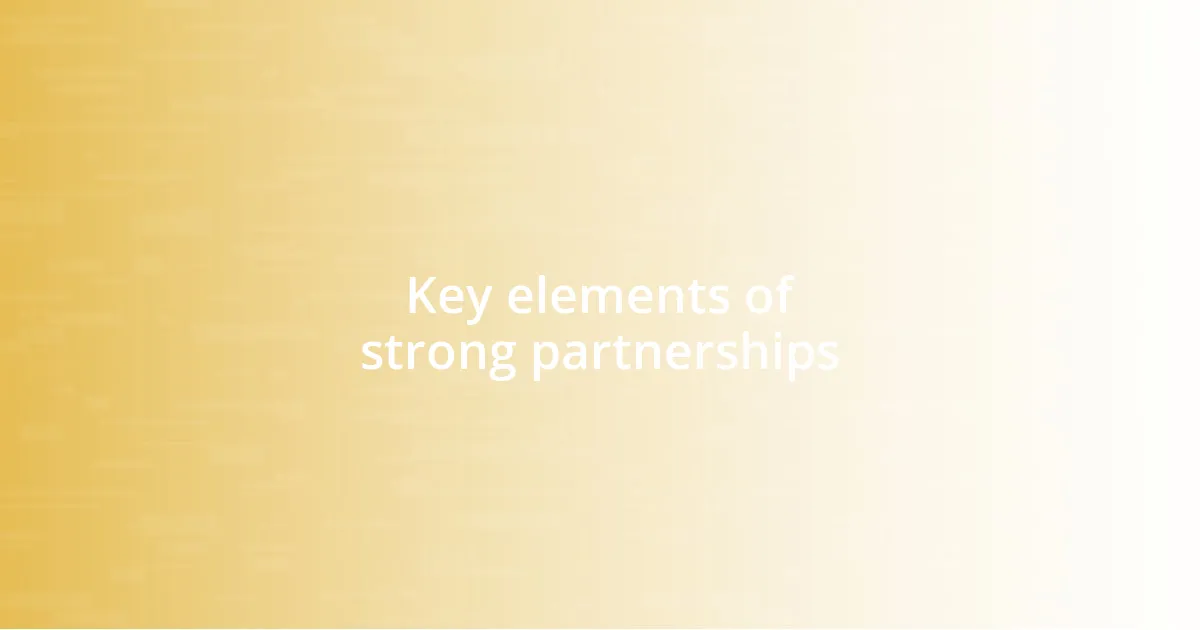
Key elements of strong partnerships
Effective collaborative partnerships rest on a few essential elements that really elevate the connection. For me, having complementary skills and experiences creates a powerful dynamic. I remember working with a partner who had a different expertise than mine; while I enjoyed creative design, they were brilliant at analytics. Our contrasting strengths shaped our project in unexpected ways, leading us to solutions neither of us could have achieved alone. This collaboration not only produced high-quality work but also taught me the beauty of appreciating different talents.
Another vital component is the ongoing commitment to cultivating the relationship. I once had a business relationship that soured over time due to lack of regular check-ins. By neglecting to communicate, we fell out of sync, and our initial excitement waned. It struck me how important it is to prioritize these touchpoints—not just for project updates but to strengthen our connection. Genuine interest in each other’s goals and challenges fosters trust and deepens the partnership.
Lastly, flexibility plays a crucial role. Partnerships can sometimes take unexpected turns, and I’ve learned that adaptability is key. In one instance, a project pivoted rapidly due to market changes. Rather than resist the new reality, I discussed it openly with my partner, and together we redefined our strategies. This experience underscored how being open to change can lead to innovative solutions we hadn’t considered before.
| Key Element | Importance |
|---|---|
| Complementary Skills | Enhances problem-solving and creativity |
| Ongoing Commitment | Builds trust and reinforces connection |
| Flexibility | Encourages adaptability to new challenges |
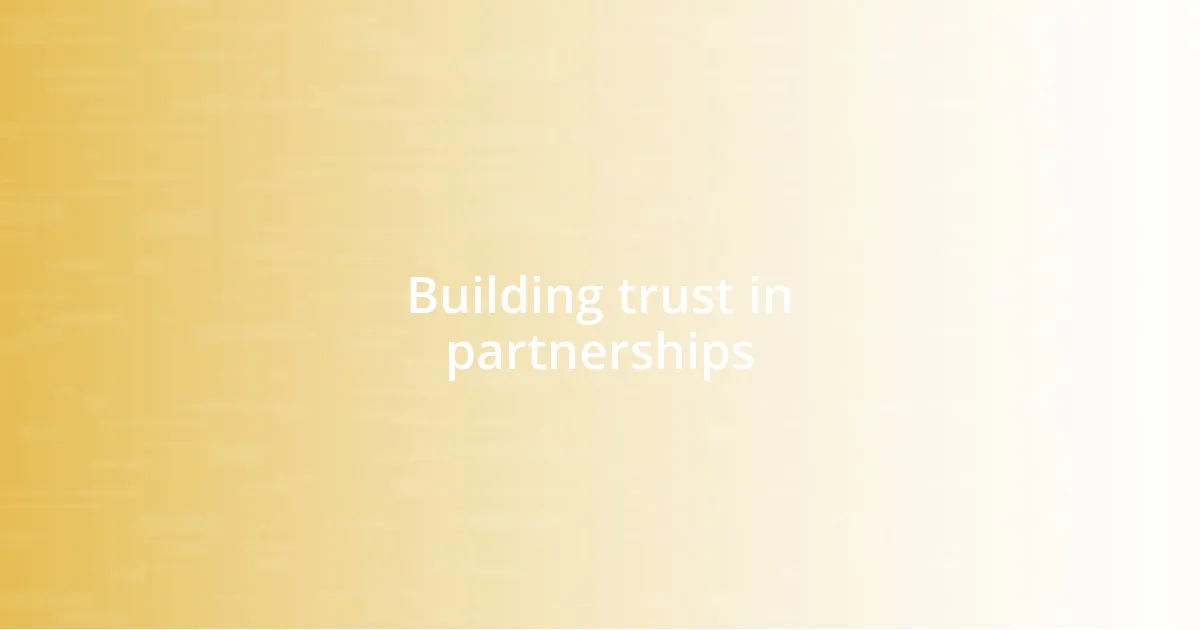
Building trust in partnerships
Building trust in partnerships is a delicate balance that requires deliberate effort. I often think about a partnership I once had with a colleague who was initially a bit reserved. It took several roundtable discussions and transparent conversations for us to find our stride. What surprised me was how vulnerability in sharing our concerns actually opened the door to deeper trust between us. Have you ever felt that sense of relief when someone lets their guard down? It’s incredible how that moment can lay the groundwork for a stronger connection.
Moreover, I find that consistency is crucial in nurturing this trust. In one project, my partner and I established a routine for weekly check-ins, which became our safe space. These sessions weren’t just about project updates; they encompassed sharing our progress, challenges, and even personal milestones. I remember the warmth in our interactions as we celebrated small wins together. Can we really underestimate the power of shared joy? I believe those moments forged a commitment that reinforced our bond.
Lastly, active listening can be a game changer in trust-building. I’ve witnessed partnerships faltering when one side dominated conversations. I learned this the hard way during a challenging negotiation, where I focused mostly on my agenda. It wasn’t until I took a step back to listen carefully to my partner’s perspective that I realized their concerns were valid and crucial. By acknowledging their input, I saw trust blossom, and our partnership strengthened in ways I hadn’t anticipated. Do you actively listen? Making the effort to understand another’s viewpoint often paves the way for a profound connection.
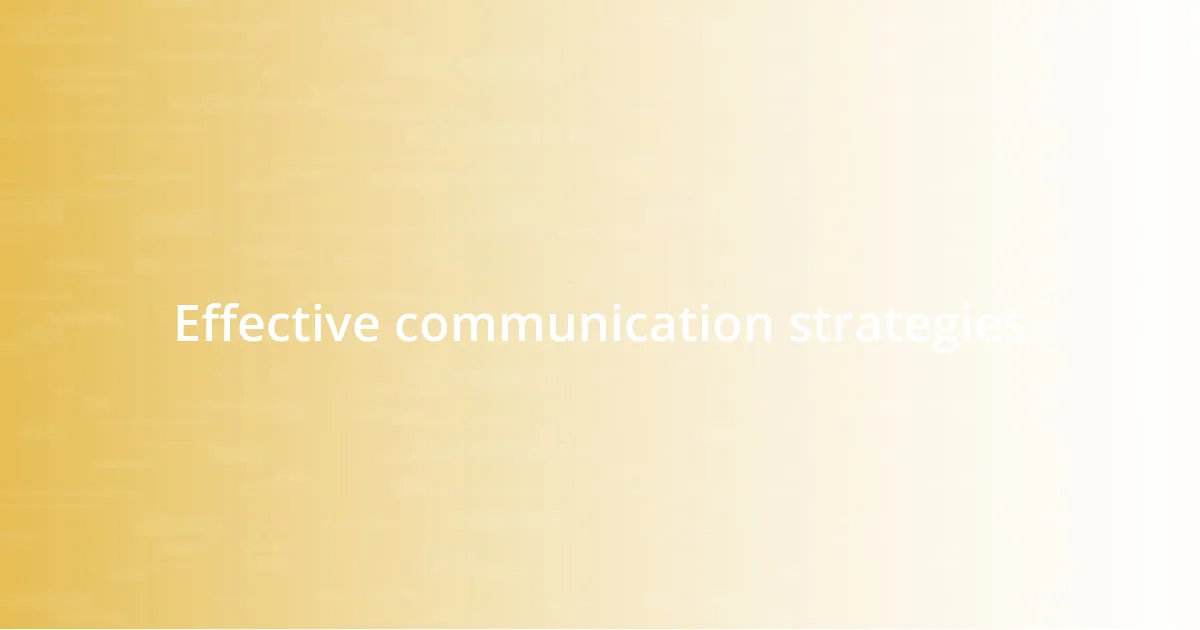
Effective communication strategies
Effective communication is the glue that holds partnerships together. I remember a time when my partner and I were stuck on a project, each of us stubbornly clinging to our ideas. It wasn’t until we sat down and actively listened to each other that clarity emerged. Have you ever experienced that moment when a simple conversation ignites new possibilities? It’s remarkable how just voicing our thoughts can shift the entire dynamic.
Setting clear expectations is another strategy I value in communication. In one of my previous collaborations, we spent time at the outset defining our roles and goals. This agreement became our guiding star, preventing misunderstandings down the road. I can’t stress enough how crucial it is to be on the same page—how else can we navigate challenges effectively? A well-defined roadmap keeps us aligned, even when unexpected bumps arise.
Lastly, I find that regular feedback loops are essential. I recall an instance where I hesitated to provide constructive criticism to a partner; I was worried about hurt feelings. Reluctance faded when I saw how much they appreciated honestly discussing our work. It allowed us to grow together and adapt our strategies. Isn’t it fascinating how a small act of transparency can lead to monumental improvements in collaboration? Embracing open dialogue has truly transformed the way I approach partnerships.
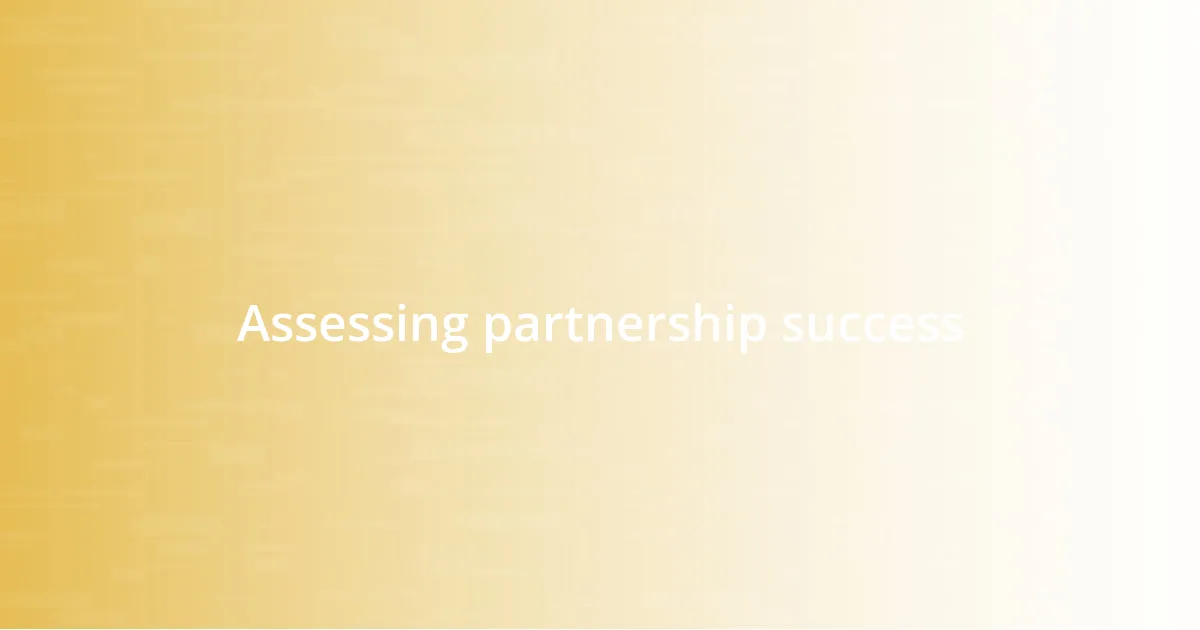
Assessing partnership success
Assessing the success of a partnership often hinges on tangible results and mutual satisfaction. I remember collaborating with a small team where we set measurable outcomes at the beginning. By reflecting on those benchmarks regularly, we could celebrate the progress and pinpoint areas where adjustment was needed. Isn’t it rewarding to look back and see how far you’ve come together?
Another crucial aspect lies in the emotional side of the partnership. I once realized that even if a project was completed on time, the team’s morale was just as important. There was a project where everyone seemed to be going through the motions, but when we took a moment to discuss how we felt about the process, it transformed everything. Have you ever noticed how addressing feelings can sometimes unveil underlying issues that impact performance?
Lastly, seeking feedback from all parties involved has been invaluable. I discovered this during a partnership that had plateaued; asking for insights from team members sparked new conversations and fresh ideas. It’s astonishing how sometimes the best lessons come from those we think are silent observers. How often do you check in with your partners? That inquiry can open the door to growth and renewal in ways we might not expect.
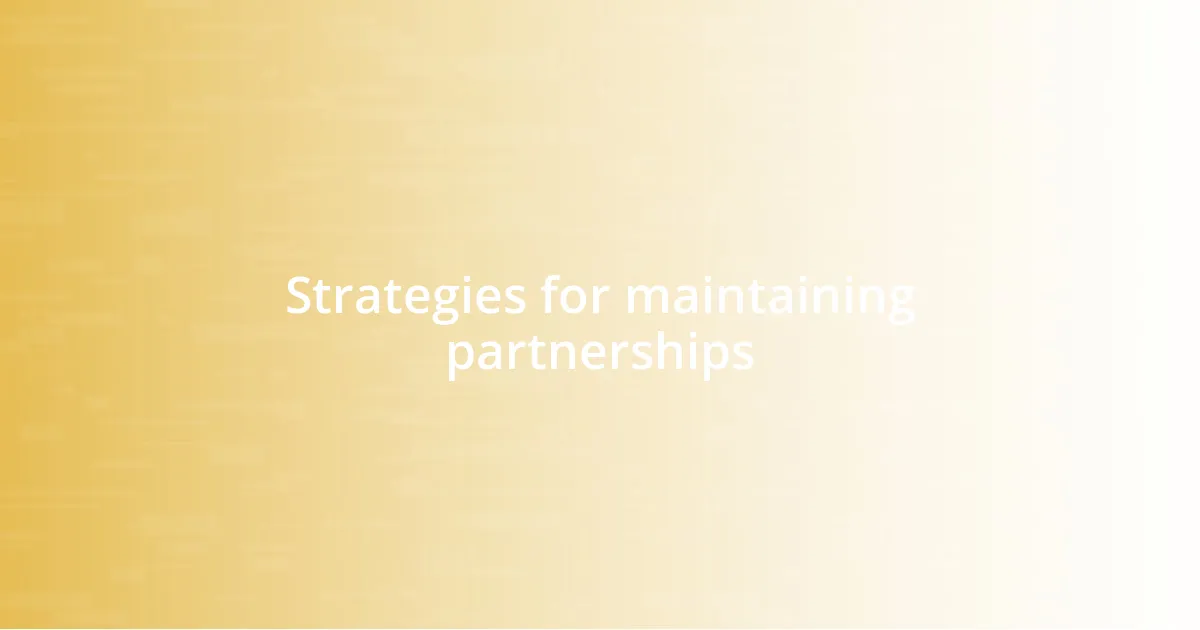
Strategies for maintaining partnerships
One of the strategies that I’ve found incredibly effective for maintaining partnerships is scheduled check-ins. When I first started collaborating with a friend on a community project, we decided to set a weekly touchpoint, even if just for 15 minutes. These quick conversations became a safe space where we could celebrate wins and address concerns early. Have you ever noticed how a tiny commitment can turn into a pivotal routine? It transformed our partnership into a proactive one while reinforcing accountability.
Another strategy involves fostering a culture of appreciation. I once worked with a colleague who never failed to express gratitude for my contributions, even the small ones. This simple act not only boosted my morale but created a ripple effect; I began to make a conscious effort to show appreciation in return. Doesn’t it feel good to be recognized for your hard work? Acknowledging each other’s efforts can reinforce the partnership bond and motivate everyone to give their best.
Lastly, I’ve learned that flexibility is key. During a recent collaboration on a marketing campaign, my partner and I encountered unexpected challenges that required us to pivot. Instead of sticking to our original plan, we embraced the change and adjusted our approach together. Have you ever realized that sometimes the best ideas come from adapting? Being open to re-evaluating our strategies enabled us to navigate obstacles more smoothly and helped strengthen our partnership even further.










